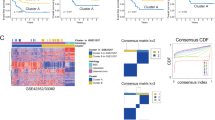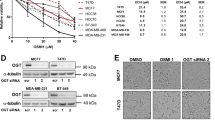Abstract
The oncogene EWS-FLI1 encodes a chimeric transcription factor expressed in Ewing's sarcoma family tumors (ESFTs). EWS-FLI1 target gene expression is thought to drive ESFT pathogenesis and, therefore, inhibition of EWS-FLI1 activity holds high therapeutic promise. As the activity of many transcription factors is regulated by post-translational modifications, we studied the presence of modifications on EWS-FLI1. The immuno-purified fusion-protein was recognized by an antibody specific for O-linked β-N-acetylglucosaminylation, and bound readily to a phosphoprotein-specific dye. Inhibition of Ser/Thr-specific phophatases increased EWS-FLI1 molecular weight and reduced its O-GlcNAc content, suggesting that phosphorylation and O-GlcNAcylation of EWS-FLI1 interact dynamically. By mutation analysis, O-GlcNAcylation was delineated to Ser/Thr residues of the amino-terminal EWS transcriptional-activation domain. Metabolic inhibition of the hexosamine biosynthetic pathway abrogated O-GlcNAcylation of EWS-FLI1 and interfered specifically with transcriptional activation of the EWS-FLI1 target Id2. These results suggest that drugs modulating glycosylation of EWS-FLI1 interfere functionally with its activity and might, therefore, constitute promising additions to the current ESFT chemotherapy.




Similar content being viewed by others
References
Araya N, Hiraga H, Kako K, Arao Y, Kato S, Fukamizu A . (2005). Transcriptional down-regulation through nuclear exclusion of EWS methylated by PRMT1. Biochem Biophys Res Commun 329: 653–660.
Aryee DN, Kreppel M, Bachmaier R, Uren A, Muehlbacher K, Wagner S et al (2006). Single-chain antibodies to the EWS NH(2) terminus structurally discriminate between intact and chimeric EWS in Ewing's sarcoma and interfere with the transcriptional activity of EWS in vivo. Cancer Res 66: 9862–9869.
Delattre O, Zucman J, Plougastel B, Desmaze C, Melot T, Peter M et al (1992). Gene fusion with an ETS DNA-binding domain caused by chromosome translocation in human tumours. Nature 359: 162–165.
Deloulme JC, Prichard L, Delattre O, Storm DR . (1997). The prooncoprotein EWS binds calmodulin and is phosphorylated by protein kinase C through an IQ domain (in process citation). J Biol Chem 272: 27369–27377.
Guinamard R, Fougereau M, Seckinger P . (1997). The SH3 domain of Bruton's tyrosine kinase interacts with Vav, Sam68 and EWS. Scand J Immunol 45: 587–595.
Gupta R, Brunak S . (2002). Prediction of glycosylation across the human proteome and the correlation to protein function. Pac Symp Biocomput, 310–322.
Hart GW, Housley MP, Slawson C . (2007). Cycling of O-linked beta-N-acetylglucosamine on nucleocytoplasmic proteins. Nature 446: 1017–1022.
Kelly WG, Dahmus ME, Hart GW . (1993). RNA polymerase II is a glycoprotein. Modification of the COOH-terminal domain by O-GlcNAc. J Biol Chem 268: 10416–10424.
Kim J, Lee JM, Branton PE, Pelletier J . (1999). Modification of EWS/WT1 functional properties by phosphorylation. Proc Natl Acad Sci USA 96: 14300–14305.
Kim J, Lee JM, Branton PE, Pelletier J . (2000). Modulation of EWS/WT1 activity by the v-Src protein tyrosine kinase. FEBS Lett 474: 121–128.
Kovar H . (2005). Context matters: the hen or egg problem in Ewing's sarcoma. Semin Cancer Biol 15: 189–196.
Lynch G, Kemeny N, Casper E . (1982). Phase II evaluation of DON (6-diazo-5-oxo-L-norleucine) in patients with advanced colorectal carcinoma. Am J Clin Oncol 5: 541–543.
Martin K, Steinberg TH, Cooley LA, Gee KR, Beechem JM, Patton WF . (2003). Quantitative analysis of protein phosphorylation status and protein kinase activity on microarrays using a novel fluorescent phosphorylation sensor dye. Proteomics 3: 1244–1255.
Matsuoka Y, Matsuoka Y, Shibata S, Yasuhara N, Yoneda Y . (2002). Identification of Ewing's sarcoma gene product as a glycoprotein using a monoclonal antibody that recognizes an immunodeterminant containing O-linked N-acetylglucosamine moiety. Hybrid Hybridomics 21: 233–236.
Ng KP, Potikyan G, Savene RO, Denny CT, Uversky VN, Lee KA . (2007). Multiple aromatic side chains within a disordered structure are critical for transcription and transforming activity of EWS family oncoproteins. Proc Natl Acad Sci USA 104: 479–484.
Ohlson J, Enstero M, Sjoberg BM, Ohman M . (2005). A method to find tissue-specific novel sites of selective adenosine deamination. Nucleic Acids Res 33: e167.
Petermann R, Mossier BM, Aryee DN, Khazak V, Golemis EA, Kovar H . (1998). Oncogenic EWS-Fli1 interacts with hsRPB7, a subunit of human RNA polymerase II (In Process Citation). Oncogene 17: 603–610.
Rahman A, Smith FP, Luc PT, Woolley PV . (1985). Phase I study and clinical pharmacology of 6-diazo-5-oxo-L-norleucine (DON). Invest New Drugs 3: 369–374.
Snow CM, Senior A, Gerace L . (1987). Monoclonal antibodies identify a group of nuclear pore complex glycoproteins. J Cell Biol 104: 1143–1156.
Spahn L, Siligan C, Bachmaier R, Schmid JA, Aryee DN, Kovar H . (2003). Homotypic and heterotypic interactions of EWS, FLI1 and their oncogenic fusion protein. Oncogene 22: 6819–6829.
Sullivan MP, Nelson JA, Feldman S, Van Nguyen B . (1988). Pharmacokinetic and phase I study of intravenous DON (6-diazo-5-oxo-L-norleucine) in children. Cancer Chemother Pharmacol 21: 78–84.
Wang M, Xie Y, Girnita L, Nilsson G, Dricu A, Wejde J et al. (1999). Regulatory role of mevalonate and N-linked glycosylation in proliferation and expression of the EWS/FLI-1 fusion protein in Ewing's sarcoma cells. Exp Cell Res 246: 38–46.
Wells L, Vosseller K, Cole RN, Cronshaw JM, Matunis MJ, Hart GW . (2002). Mapping sites of O-GlcNAc modification using affinity tags for serine and threonine post-translational modifications. Mol Cell Proteomics 1: 791–804.
Zhang XK, Watson DK . (2005). The FLI-1 transcription factor is a short-lived phosphoprotein in T cells. J Biochem (Tokyo) 137: 297–302.
Acknowledgements
This study was supported in part by Grant P18046-B12 of the Austrian Science Fund (FWF).
Author information
Authors and Affiliations
Corresponding author
Rights and permissions
About this article
Cite this article
Bachmaier, R., Aryee, D., Jug, G. et al. O-GlcNAcylation is involved in the transcriptional activity of EWS-FLI1 in Ewing's sarcoma. Oncogene 28, 1280–1284 (2009). https://doi.org/10.1038/onc.2008.484
Received:
Revised:
Accepted:
Published:
Issue Date:
DOI: https://doi.org/10.1038/onc.2008.484
- Springer Nature Limited
Keywords
This article is cited by
-
Acetylation dependent translocation of EWSR1 regulates CHK2 alternative splicing in response to DNA damage
Oncogene (2022)
-
Targeting the undruggable: exploiting neomorphic features of fusion oncoproteins in childhood sarcomas for innovative therapies
Cancer and Metastasis Reviews (2019)
-
Hsa-mir-145 is the top EWS-FLI1-repressed microRNA involved in a positive feedback loop in Ewing's sarcoma
Oncogene (2011)
-
Recent advances in the molecular pathogenesis of Ewing's sarcoma
Oncogene (2010)
-
More and better cure for an orphan: priorities for future paediatric cancer research in Europe – Meeting report of the EC-funded science-communication project DIRECT “Overcoming Cancer with Research”
memo - Magazine of European Medical Oncology (2009)




